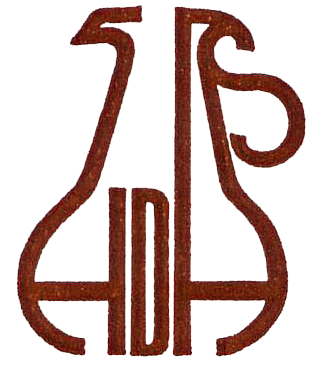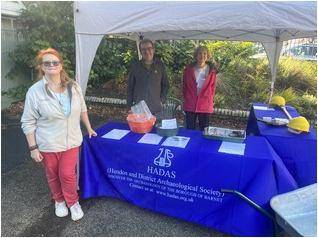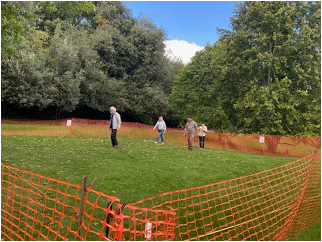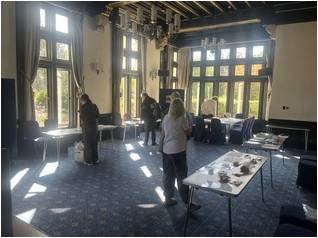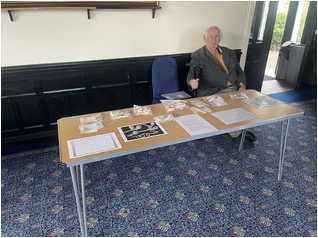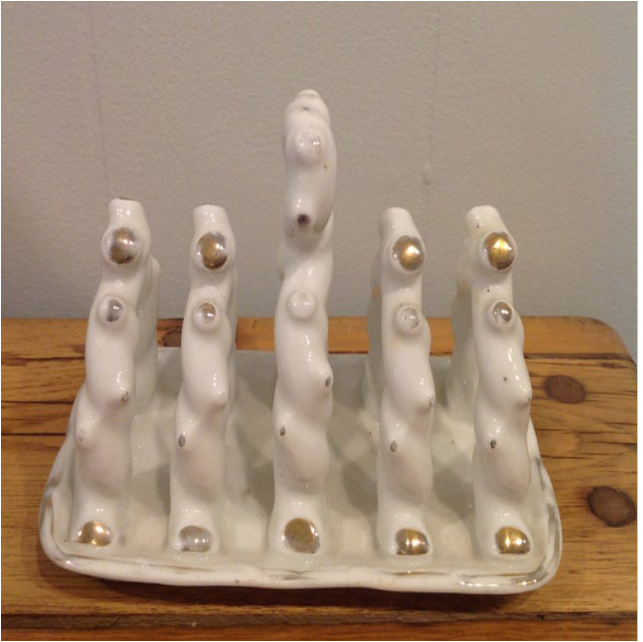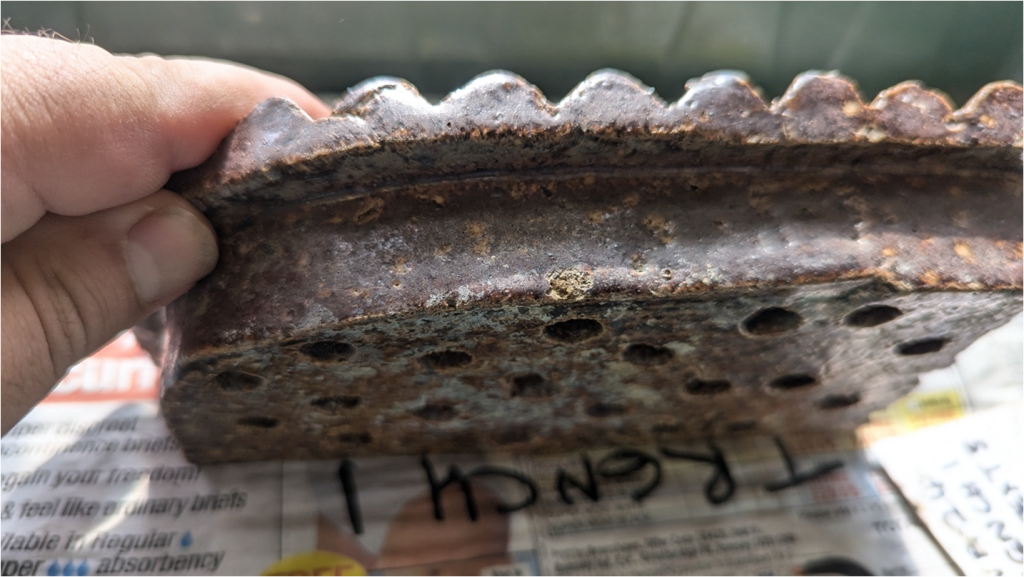
No. 656 November 2025 Edited by Sue Willetts
HADAS DIARY – Forthcoming Lectures and Events
Tuesday November 11th 2025 Dr. Signe Hoffos – “Lost Churches of the City of London: 500 years of City churches lost to fire, war and urban redevelopment”
No lecture in January 2026
Tuesday February 10th 2026 Dr James Bromwich. “Great archaeological discoveries and great archaeologists of France: Alexandre du Mège: a founder of archaeological research in France – or rogue? Léon Joulin: an outstanding intellect and a founder of modern archaeology. Émile Chénon: a leading nineteenth century lawyer with a love for archaeology. Sophie Krausz: in the forefront of twenty-first century archaeology and museum presentation”
Lectures held in the Drawing Room, Avenue House, 17 East End Road, Finchley N3 3QE. 7.45 for 8pm.
Buses 13, 125, 143, 326, 382, and 460 pass close by, and it is a five-ten-minute walk from Finchley Central Station on the Barnet Branch of the Northern Line where the Super Loop SL10 express bus from North Finchley to Harrow also stops. Tea/Coffee/biscuits available for purchase after each talk.
There is a correction to the last newsletter (Oct 2025). Page 2, second paragraph, ref the Avenue House Sunday morning working parties. If you are interested in these please contact me at: bill_bass@yahoo.comThe address given in the newsletter will not work
HADAS Festive Celebration will be on something to look forward to in the new year it will be on Sunday the 18th of January 2.30-5.30 pm in the larger Drawing room of Avenue House. Please return the Booking Form to Roger Chapman by the end of November if you are interested. The cost is £20 pp and will be finger food as before. The booking details are on the enclosed booking form.
PROPOSED HADAS TRIP 2026 DATE. April 3 nights, 4 days Sue Loveday
We have looked into resuming a HADAS trip for next April 2026 as so many people enjoyed the previous trips organised by Jim and Jo. The trip would be to the Derby / Peak District area and would only be viable if enough people were interested. Some have visited the area before but there is a lot to see in the area. The outward trip would be with a stop in Coventry and tour / history of Coventry Cathedral – possibly another site – before heading to Derby to the hotel where we will be based. Our stay will include Dinner, Bed and Breakfast there. (Looking into lunch stops/if individuals can request packed lunch). The next day it is our intention to visit one of the area’s larger caves (Derby is known for the number of caves) with wondrous formations and to learn about its history through the ages, explored by archaeologists. The main chamber /entrance has accessibility to mobility users – there are some steps up and down involved in inner chamber. The Visitor Centre, Shop and cafe site says it’s accessible. Another day we will
1 of 8
visit the Mills, very much part of the area and we’d hope to include a heritage train ride. Then going on to some museums with archaeological finds and also learn more about the area’s history of innovation.
The higher price is for single occupation/supplement but looking to see if anything can be done further. Entrance fees also included in price, i.e. cavern, train ride plus other etc. The coach price reflects number of people we get. If would like to come please email Sandra, chairman@hadas.org.uk.
Open day Janet Mortimer
On Sunday 21st September HADAS held an Open Day at Stephens House and Gardens. Despite there being rain predicted earlier in the week, the sun shone bringing lots of visitors to the gardens. HADAS had a stand in the courtyard showing finds from their summer dig in Church End, Hendon where their star find was a Saxon pin dating back to the 7th or 8th century.
The HADAS stand – with new table covers showing our logo- showed why, where and how we carry out archaeological digs and what happens to the finds as they are processed afterwards. On the lawn a resistivity demonstration took place with members of the public able to try out the equipment for themselves. Inside the house were more finds from previous digs including a display of flint artefacts made by Mesolithic people over 7,000 years ago which were discovered during a dig on Hampstead Heath.
2 of 8
There was a display of clay pipes with explanations of how they are a useful dating aid and a collection of ancient fossils. Children were catered for with free activities such as colouring roman mosaics, making their own Saxon shields on paper plates, making bookmarks with their name in Viking runes and a fun quiz. There was also a popular tombola with children’s items with an archaeological theme. It was very pleasing to see a steady stream of visitors throughout the day.
CVA24 Church Road – Pottery Report – Trench 1 Melvyn Dresner
Toast Rack (Tim Curtis, text and photos)
It comprised 9 conjoining fragments of about 2/3 of a white glazed ceramic toast rack base, with the attachment scars of 4 vertical partitions for holding toast slices (see picture 1).
Picture 1
The base was a flat hexagonal plate with raised edges to retain stray toast crumbs. The partitions were constructed from hollow tubes in a figure-8 pattern (Picture 2).
Picture 2
Only 1 separate partition tube fragment was recovered.
3 of 8
There were probably 5 partitions to hold 4 slices of toast, with a ring handle on the central one for carrying and passing round the table (see example picture 3).
Picture 3
The earliest known examples of toast racks date from the 1770s,
This decorative ceramic example is probably of mid-Victorian age. It’s location in context 003 places it potentially in phase 3 of the occupation of the site, the Baptist Church and the working men’s club.
Stove top (Susan Trackman, pers comm)
Ceramic tiles, with ridges and perforations, probably from stove top or room heater, probably imported from continental Europe (Belgium, France, or German/ Austrian), decorative and small scales suggested used to warm parlour.
Photo shows perforations of stove top:
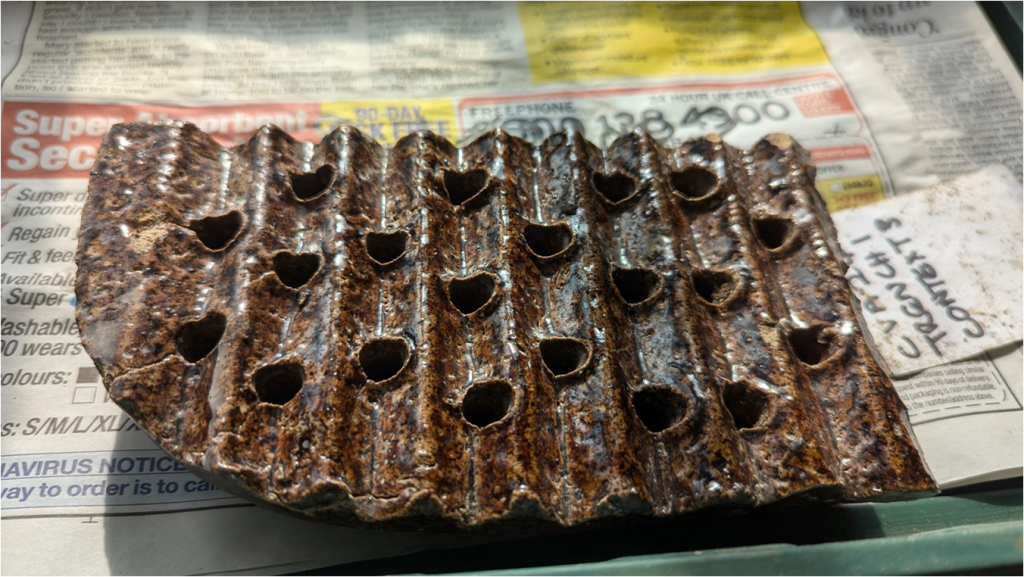
4 of 8
Photo shows lip to enable cover to sit securely on stove:
Photo from below
Bat roosts may halt study of Marlborough Mound Stewart Wild
Plans to cut into a 4,000-year-old mound to allow further research on its history could be stopped by the presence of bats. The Castle Mound in Wiltshire, also known as the Marlborough Mound, is the second largest Neolithic mound in Europe at 62ft high. Marlborough College has applied for planning permission to try to “enhance its setting” by demolishing school buildings that “cut into” the west side of the mound. The aim is to carry out further archaeological research when the buildings are gone – and eventually put in a curved stone-faced support to reinforce the mound.
But the presence of bats, which are protected, could halt the project. In documents to support the application, the College said the mound was a “nationally important scheduled monument” with significance including its prehistoric use, artistic interest and historic links to the Seymours, the family of Henry VIII’s third wife Jane. The mound has been carbon dated to 2400BC and features part of a medieval castle as well as some 17th- and 18th-century garden features.
Wiltshire Council is expected to decide on the application in September, but the council’s ecology team has raised concerns that the buildings being earmarked for removal could be a haven for bats. It said in a report:”The buildings on site appear to have some potential for roosting bats and there are records of bats in the local area. “The ecology team should be reconsulted once the results of all the surveys are available. In carrying out its statutory function, the authority must be reasonably sure that the proposal will not result insignificant adverse effects on protected habitats or species.”
The works are intended to enhance the visitor experience of the new Mound Information Centre which is being completed in the College grounds. The buildings embedded into the mound include a decommissioned plant room, disused toilet block and a carpentry workshop which all have little or no heritage value, according to the College. SOURCE: Daily Telegraph, 21 July 2025, item edited by Stewart Wild
5 of 8
Ancient Egyptian’s handprint found on clay model Stewart Wild
A hand print left 4,000 years ago on a clay model crafted to go inside an Egyptian tomb has been discovered during preparation for an exhibition later this year. The imprint was left on the base of a “soul house”, a clay model in the shape of a building which would then be placed inside a burial chamber. The model on which the hand print was discovered has been dated to around 2050 to 1650 BC. It had an open front space where items of food were laid out, in this example, loaves of bread, a lettuce and an ox’s head. Soul houses may have acted as offering trays or provided a place for the soul of the deceased to live within the tomb.
Helen Strudwick, senior Egyptologist at Cambridge’s Fitzwilliam Museum, said: “We’ve spotted traces of fingerprints left in wet varnish or on a coffin in the decoration, but it is rare and exciting to find a complete handprint underneath this soul house. This was left by the maker who touched it before the clay dried. I have never seen such a complete handprint on an Egyptian object before.”
The researcher, who is also curator of the museum’s new Made in Ancient Egypt exhibition, continued:”You can just imagine the person who made this, picking it up to move it out of the workshop to dry before firing. Things like this take you directly to the moment when the object was made and to the person who made it, which is the focus of our exhibition.” Analysis of the item suggests that the potter who made it first created a framework of wooden sticks and then coated it with clay to make a building with two storeys supported by pillars. Staircases were formed by pinching the wet clay. During firing the wooden sticks burnt away, leaving empty spaces in their place. The hand print found underneath was probably made when someone, perhaps the potter, moved the model out of the workshop to dry before firing in a kiln.
The soul house will be on display in the museum’s Made in Egypt exhibition which opens to the public on Friday 3 October. SOURCE: Daily Telegraph, 28 July 2025, item edited by Stewart Wild.
Exhibitions
Bloomberg Mithraeum – Exhibition. 17 July – 10 January 2026 https://www.londonmithraeum.com/bloomberg-space/
Jane and Louise Wilson: Performance of Entrapment. This exhibition centres 2,000-year-old oak stakes discovered during excavations for Bloomberg’s European headquarters believed to have once supported a crossing over the River Walbrook – an ancient waterway that flowed beside the Temple of Mithras and still runs beneath the streets of modern London. Using microscopic imagery, the Wilsons draw inspiration from the wood’s structure and DNA sequencing, to create large-scale, visually layered artworks.
Performance of Entrapment investigates parallels between the Roman Temple of Mithras and Ise Jingu shrine in Japan — two sacred sites – the Roman Temple of Mithras (3rd Century AD) and Japan’s Ise Jingu shrine (4th Century BC). Though geographically and culturally distant, they both feature similarities in iconography and house significant relics: the head of Mithras in London, and the Sacred Mirror of the Emperor at Ise Jingu. A film by the Wilsons, created with shrine authorities within the grounds of Ise Jingu, explores sisterhood, duality and renewal. Please note: this exhibition contains occasional flashing lights, which may affect individuals with light sensitivity or photosensitive epilepsy. Strobe lighting is not in use.
British Library, London. Secret Maps. 24 October 2025 – 18 January 2026.
Who shapes your world? Who decides what you see? What hides behind grid lines? Tickets £20
Concession and off-peak pricing available. Step into the shadows at Secret Maps, a major new exhibition revealing the stories hidden in some of history’s most mysterious maps from the 14th century to the present day.
6 of 8
OTHER SOCIETIES’ EVENTS Eric Morgan
As always, please check with the Societies’ websites before planning to attend, since not all Societies or organisations have returned to Pre-Covid conditions.
17th November, 7.30 pm. Enfield Society. Jubilee Hall, 2 Parsonage Lane/Junction Chase Side, Where are London’s Monasteries? Talk by Andrew Gray on the monasteries that existed in London before the Dissolution. Please visit www.enfieldsociety.org.uk Non-members charge £1.
Tuesday 25th November, 1 pm. Society of Antiquaries, Burlington House, Piccadilly, London, W1J 0BE.Wedded to the Realm: Queen Mary I, The Guildhall Speech, and a Spousal Ring. Talk by Valerie Schutte. Also on Zoom. Free. Visit https://www.sal.org.uk/events/ to book.
Tuesday 25th November, 7.15 pm. Hornsey Historical Society. Union Church Hall, Corner Ferme Park Road/Weston Park, London. N8 9PX. English Public Libraries’ Architecture, 1850-1930. Talk by Ray Rogers (HHS). Please visit www.hornseyhistorical.org.uk here may be a request for a donation of £5.
Tuesday 2nd December, 11am. Enfield Society. Jubilee Hall, 2 Parsonage Lane/Junction Chase Side, Enfield, EN2 0AJ. Pleasure Gardens: A Place to see and be seen. Talk by Julie Chandler on London’s famous Pleasure Gardens. Please visit www.enfieldsociety.org.uk Non-members charge £1.
Wednesday 3rd December, 4.30 pm. Thames and Docklands History Group – London Museum of Docklands, No 1, West India Quay, off Hertsmere Road, London. E14 4AL. The Thames Tunnel- 8thWonder of the World! Talk by Robert Hulse (Brunel Museum). https://www.tdhg.org.uk/event-details/the-thames-tunnel-eighth-wonder-of-the-world.
Sunday 7th December, 10.30 am. Heath and Hampstead Society – Known and Unknown Landmarks of the East Heath. Meet at Parliament Hill Bandstand, off Gordon House Road, Gospel Oak, NW5. Walk from Bandstand to Kenwood House. Led by Jeska Harrington-Gould. Lasts approx. 2 hours. Free. Further information from Tereza Pultarova on 07776 649163 or email hhs.walks@gmail.comhttps://www.heathandhampstead.org.uk/.
Tuesday 9th December, 6.30 pm. L.A.M.A.S. Talk on Zoom. Farms, Playhouse and Taverns: by Sarah Wolfaston and Steve White. Radical Experiments and Liberation in Whitechapel. Excavations on the site of Stepney Way, Whitechapel in 2018-19 and its main discoveries from Iron Age to Medieval and Tudor. Please visit www.lamas.org.uk.
Tuesday 9th December, 8 pm. Amateur Geological Society. Talk on Zoom. Fossil Bryozoans from the Chalk, by Dr. Paul Taylor (National History Museum). Among the most common fossils in the chalk of colony forming animals. Please visit https://amgeosoc.wordpress.com/meeting-dates/ for details and link.
Tuesday 9th December, 8 pm. Historical Association (North London Branch). Jubilee Hall (Address as for Tuesday 2nd December). Christmas on Trial during the English Revolution. Talk by Dr. Ariel Hassayon (U.C.L.). Non-Members charge £2.
Wednesday 10th December, 2.30 pm. Mill Hill Historical Society. Trinity Church, 100, the Broadway, London, NW7 3TB. Baths and Bathing through the Ages. Talk by Ian Betts. www.millhill-hs.org.uk.
Thursday 11th December, 5 pm. Society of Antiquaries. Burlington House (Address as for Tuesday 25th November). Scholars and Scandal – The First Publication of Samuel Pepys’ Diary. Talk by Professor Kate Loveman (FSA). Also on Zoom. Free. To book visit www.sal.org.uk/events.
7 of 8
Friday 12th December, 7.30 pm. Enfield Archaeological Society. Talk on Zoom. Roman Painting and Decoration. By Han Lie (MoLA). Please visit https://www.enfarchsoc.org/ for further details and link.
Thursday 18th December, 10.40 am. The Arts Society, Enfield, Revival Christian Church, 47, London Road, Enfield. EN2 6DS. Christmas in Bach’s Leipzig – The Christmas Oratorio of 1734/5. Talk by Sandy Burnett. Visitors fee £10. https://theartssocietyenfield.org.uk/Lectures/FutureLectures.aspx.
Thanks to our contributors this month: Melvyn Dresner, Sue Loveday, Eric Morgan, Janet Mortimer, Stewart Wild
Hendon and District Archaeological Society
Chair Sandra Claggett, c/o Avenue House, 17 East End Road, Finchley N3 3QE
email : chairman@hadas.org.uk
Hon. Secretary Janet Mortimer 34 Cloister Road, Childs Hill, London NW2 2NP
(07449 978121), email: secretary@hadas.org.uk
Hon. Treasurer Roger Chapman, 50 Summerlee Ave, London N2 9QP (07855 304488)
email: treasurer@hadas.org.uk
Membership Sec. Vacancy. A new volunteer is needed. If you are interested please contact
Sandra on the Chairman email address above to discuss.
Website: www.hadas.org.uk
HADAS is registered with the UK Charity Commission (Registration number 269949)
8 of 8
